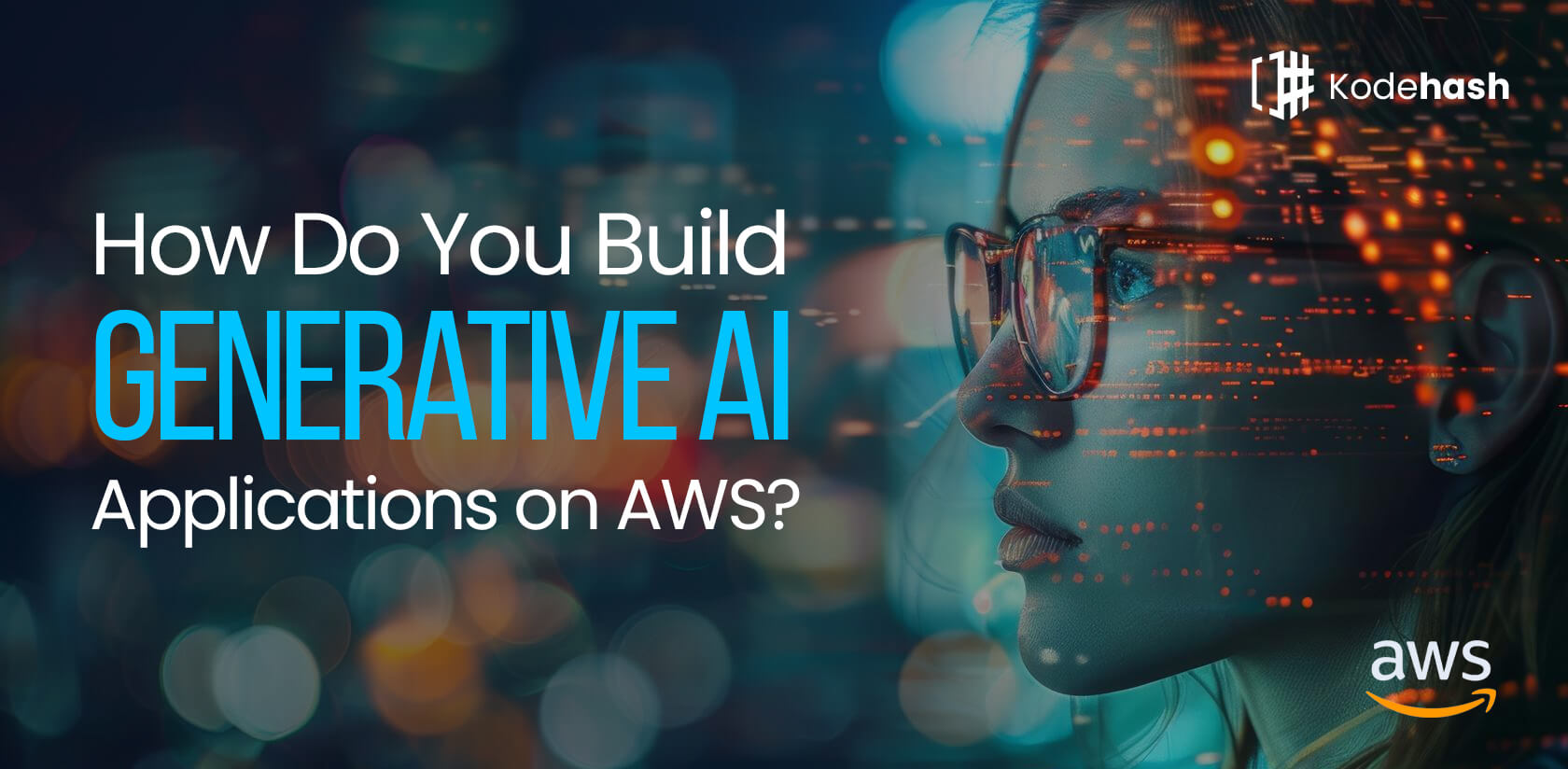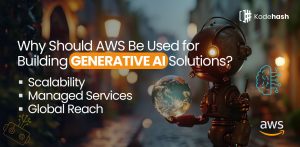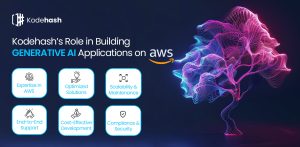How Do You Build Generative AI Applications on AWS?

Generative AI Applications are transforming business operations. From creating content to designing software, generative AI holds immense potential. Even for generating personalized customer experiences, it works best. Generative AI applications are building scalable, flexible, and powerful AWS. As a result, businesses are improving and touching innovation without any limit.
Let’s delve into how Generative AI Applications collaborate with AWS. And how Kode hash is becoming a helping hand in providing a seamless process.
Understanding Generative AI Applications
Generative AI applications create new content or data. The existing data help them to learn how to generate text, images, music, and video. The popular tools of these applications are OpenAI’s GPT models, DALL·E.
Generative AI application building on AWS helps to tap into cloud resources. The resources help in delivering scalable infrastructure. And the managed services through these resources make efficient and cost-effective processes.
Why Choose AWS for Generative AI?
How do I get started on AWS with the development of Generative AI applications?
Generative AI applications are trendsetters for undertaking business operations. This application one can be used for content creation software design and customer experience customization. On AWS, generative AI applications are flexible, scalable, and potential. Every business will be able to develop such applications with AWS support.
Exploring Uses of Generative AI
This form of AI generates something new, may it be content or data. One can create information in many forms such as text, picture, motion or video format. To shape into different formats applications need help from other information for better understanding. Learning from others can involve GPT models for Open AI, DALL’E, etc.
When developing generative AI applications on AWS, what you get are cloud services that provide reliable, cheap, and easily scalable infrastructure and services.
Why Should AWS Be Used for Building Generative AI Solutions?

Developing generative AI applications is flexible with AWS. Because AWS offers a robust platform: Here find out the reasons:
Scalability: AWS can scale resources as your application grows.
Managed Services: AWS provides pre-built AI and machine learning services.
Security: The platform provides advanced security protocols to ensure better data protection.
Global Reach: AWS operates globally, ensuring your AI applications can reach users anywhere.
These attributes make AWS the best platform for establishing generative AI solutions. Now, it is necessary to describe possible actions in more detail Here, we discuss the following steps:
Step-by-Step Procedure to Build Generative AI Applications on AWS
3.1 Data Preparation
When you are discussing Generative AI applications, you cannot ignore raw data. Pre-processing for AWS starts with the importation of your dataset into Amazon S3( Simple Storage Service). Security, high durability, and scalability are the benefits you can receive from S3.
Clean the Data: Preprocessing plays the key role here. You can use tools such as AWS Glue to clean and prepare your data. Make sure it is structured effectively to meet the training purpose.
3.2 Select a Model
The other approach is to use pre-designed models. AWS makes both options easy.
Amazon SageMaker: This is an ongoing service utilized for building, training, and deploying AI models. TensorFlow or PyTorch from SageMaker is a few names among popular frameworks that can build machine learning models. SageMaker simplifies building models at the time of facing a blank page immediately.
Pre-trained Models: AWS offered models from Amazon AI such as BERT and GPT-3 help to optimise your application smoothly.
3.3 Train the Model
After receiving your data and model, your next step would be the training.
Amazon SageMaker comes with Managed Spot Training. This option lets you run models at a lower cost by taking advantage of unused AWS compute capacity.
The model’s complexity and data set size can differentiate the training time. Generative AI applications often require extensive training, so the ability to scale resources is critical. AWS provides flexibility in selecting GPU or TPU instances, ensuring optimal training performance.
3.4 Optimise the Model
Optimization ensures that your generative AI model performs efficiently. AWS offers several tools for this:
Amazon SageMaker Neo: It optimizes machine-learning models for specific hardware platforms.
AutoML Tools: Use these for automatic model tuning, which helps reduce time and ensures the model works well in production.
3.5 Deploy the Model
Once the training phase is complete, move towards the next step which is to deploy the mode. SageMaker provides the additional benefit of easily deploying through endpoints within AWS.
Amazon Elastic Inference: This service helps decrease the operating cost of deep learning inference by integrating GPU-based inference boost to EC2 and SageMaker instances.
API Gateway: If you are using AWS then you can connect your model with AWS API Gateway for creating APIs to engage with your AI model. This makes it possible for your application to take requests and responses, and create content using artificial intelligence in real-time.
3.6 Monitor and Improve the Model
Post-deployment monitoring is crucial. AWS offers various tools for this.
Amazon CloudWatch: Use this to monitor application performance and identify bottlenecks.
Amazon SageMaker Debugger: It finds out the training complexities to develop accurate models over time.
Model Retraining: Retraining the model periodically ensures that it stays relevant. Improve accuracy and efficiency with collected forms of data.
Kodehash’s Role in Building Generative AI Applications on AWS
While AWS provides the platform, leveraging it efficiently requires expertise. That’s where Kodehash comes in.

Expertise in AWS
Kodehash brings years of experience working with AWS, enabling businesses to unlock the full potential of generative AI. Their team ensures that every aspect, from data preparation to deployment, is handled with precision.
Optimized Solutions
Kodehash customized solutions based on business needs. Whether it’s selecting the right AWS services or fine-tuning pre-trained models, they ensure everything runs smoothly.
End-to-End Support
From consulting to post-deployment monitoring, Kodehash provides end-to-end support. They also offer staff augmentation services, ensuring businesses have access to skilled AI engineers who can build and maintain generative AI applications on AWS.
Cost-Effective Development
Generative AI applications can become resource-intensive. Kodehash helps businesses reduce costs by optimizing resource use, such as utilizing Amazon EC2 Spot Instances and Elastic Inference.
Scalability and Maintenance
Kodehash ensures that applications built on AWS can scale effortlessly. As businesses grow, the applications grow with them. Kodehash also provides maintenance services to ensure that applications remain efficient and effective over time.
Compliance and Security
Data security is critical in generative AI applications, especially when dealing with customer data. Kodehash ensures all applications are compliant with data privacy regulations and that AWS’s advanced security features are fully utilized.
Case Study: Kodehash and Generative AI on AWS
Find a perfect example of Generative AI on AWS at Kodehash’s work with a digital media company. Precisely the company wished to use artificial intelligence in automating content generation. This was how Kodehash assisted them in creating a generative AI application in the AWS platform. It delivers services such as writing blog articles, providing product descriptions, along with social media content creation.
The training purpose allows the team to utilize Amazon SageMaker and pre-trained models such as GPT-3. To run the model they used Amazon API Gateway to create an API that produced good content within the blink of an eye. By applying the optimization strategies developed by Kodehash, the training time was decreased by a third and the inference costs decreased by a quarter.
In this case, it can be indicative of how Kodehash is helping further the use of AWS for generative AI and the tangible outcomes being created.
Best Practices for Building Generative AI Applications on AWS
Building generative AI applications on AWS comes with challenges. Here are some best practices to ensure success:
- Data Quality: Ensure high-quality data for training. The model’s performance will depend on it.
- Cost Optimization: Use Spot Instances and services like Elastic Inference to save on compute resources.
- Scalability: It’s always important to incorporate scalability in the design process. AWS makes this easy, but there has to be proper planning now and again.
- Security: Adhere to acceptable rules of data protection in terms of privacy. Some features including IAM, AWS Shield, and AWS WAF are provided to ensure application security.
Generative AI and AWS – The Future
Generative AI holds a rich promise for the future. AWS keeps on adding to their collection more solutions for developing artificial intelligence applications. Here are some trends to watch:
- More Pre-trained Models: Pre-trained models will continue to be a part of AWS services as the company releases more of them—AI development will be accelerated.
- Edge AI: AWS is focusing on AI at the edge, allowing generative models to run on devices, and reducing latency.
- AutoML: Expect more AutoML tools, simplifying the process of training and deploying generative AI models.
- Kodehash will continue to lead in these areas, ensuring businesses stay ahead of the curve by adopting the latest AWS technologies.
Final Thought
Any generation of generative AI applications on AWS needs a strong technical appreciation of machine learning as well as cloud computing. AWS provides an environment of flexibility, discretion, and the means to create strong AI solutions. with Kodehash, organizations can now understand AWS complexities and release generative AI’s full potential.
Kodehash as a partner helps companies to focus 100% on innovation. So that experts will do their technical part seamlessly. Regardless if you are developing a text generator, an image generation tool, or an AI-driven solution, Kodehash with AWS guarantees your application. It will perform flawlessly, optimize, and deliver on your business goals.
Recent Blogs
Subscribe:
Subscribe for the newsletter and receive email notification of every future post.




